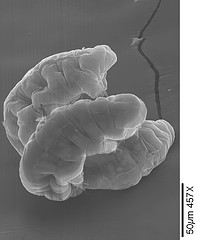
Reproduction
Tarigrades come in bothe sexes, males and females, making them gonochoristic. The females are much more common however and some Tardigrade species only the female organism has been discovered leading to the conclusion that some tardigrades are parthenogenetic (Thorp et al 2010). The Hysibius dujardini are parthenogenetic and the females lay their eggs in moulted exoskeletons and are left behind. These eggs then undergo meiosis and then duplicate their chromosomes instead of being fertilized by a male tardigrade. The adult female tardigrades usually produce 3-4 individual emrbryos each time they lay. The eggs then hatch in roughly 4 days (Halberg et al 2009).
Tardigrades are often used in experiments because of their reproductive generation period. The generation period of the Hypsibius dujardini is one week to two weeks. This combined with their amazing knack for survival make it a perfect specimen for laboratory experiments (eol.org).
The reproductive apparatus of the tardigrades usually have one or two dorsal-caudal gonads. These gonads vary greatly between species of tardigrade and also vary with age, sex, and reproductive stage (Thorp et al 2010).
